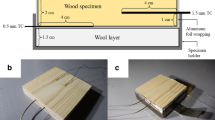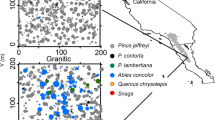Abstract
Wildfires are an integral feature of the Australian continent. To estimate the rate of spread of wildfires using computational models it is important to know the kinetic parameters of the materials that constitute the fuel load in forests. These kinetic parameters are utilised in pyrolysis and combustion sub-models of a computational model. In the present work, the kinetics of pyrolysis of timber and litter materials (consisting of bark, twigs, and leaves) from Pinus radiata and Eucalyptus obliqua subsp. messmate forests were estimated under nitrogen. The activation energy for the pyrolysis of timber was found to be independent of conversion, whereas it varied for the litter materials in the range of the pyrolysis temperatures employed. Furthermore, the parameters pertaining to a single equivalent reaction model were also identified. For the samples studied, the most suitable reaction model was identified as the Johnson–Mehl–Avrami model. The activation energy measurements reported here are consistent with measurements previously reported for other species within the Pinus and Eucalyptus genera.







Similar content being viewed by others
Abbreviations
- α :
-
The degree of conversion (dimensionless)
- α p :
-
The degree of conversion at the maxima of the differential kinetic curve at each heating rate
- A :
-
Pre-exponential factor (s−1)
- β :
-
Heating rate (K min−1)
- E :
-
Activation energy (kJ mol−1)
- f(α):
-
The general form of the kinetic model
- f′(α):
-
Derivative form of the kinetic model (d(f(α))/dα)
- g(α):
-
The integral form of the kinetic model \(\int {d\alpha /f(\alpha )}\)
- R :
-
The Universal gas constant (8.314 J mole−1 K−1)
- t :
-
Time (s)
- T :
-
Absolute temperature (K)
- x :
-
Reduced activation energy (E/RT)
- x p :
-
Reduced activation energy at the maxima of the differential kinetic curve at each heating rate
References
Jolly WM, Cochrane MA, Freeborn PH, Holden ZA, Brown TJ, Williamson GJ, Bowman DMJS. Climate-induced variations in global wildfire danger from 1979 to 2013. Natl Commun. 2015;6:7537. doi:10.1038/ncomms8537.
Sullivan AL. Wildland surface fire spread modelling, 1990–2007. 2: Empirical and quasi-empirical models. Int J Wildland Fire. 2009;18:369–86. doi:10.1071/WF06144.
Sullivan AL. Wildland surface fire spread modelling, 1990–2007. 1: Physical and quasi-physical model. Int J Wildland Fire. 2009;18:349–68. doi:10.1071/WF06143.
Sullivan AL. Wildland surface fire spread modelling, 1990–2007. 3: Simulation and mathematical analogue models. Int J Wildland Fire. 2009;18:387–403. doi:10.1071/WF06145.
Tolhurst K, Shields B, Chong D. Phoenix: development and application of a bushfire risk management tool. Aust J Emerg Manag. 2008;23:47–54.
McGrattan K, McDermott R, Floyd J, Hostikka S, Forney G, Baum H. Computational fluid dynamics modelling of fire. Int J Comut Fluid Dyn. 2012;26:349–61. doi:10.1080/10618562.2012.659663.
Ellis PF. The aerodynamic and combustion characteristics of eucalypt bark: a firebrand study. Ph.D. thesis. 2000. https://digitalcollections.anu.edu.au/handle/1885/49422. Accessed 30 June 2016.
Keeley JE. Fire intensity, fire severity and burn severity: a brief review and suggested usage. Int J Wildland Fire. 2009;18:116–26. doi:10.1071/WF07049.
Tarifa CS, Del Notario P, Moreno F, Villa A. Transport and combustion of firebrands. Final report of grants FG-SP-11 and FG-SP-146, 2USDA. 1967.
Manzello SL, Suzuki S. Experimentally simulating wind driven firebrand showers in wildland-urban interface (WUI) fires: overview of the NIST firebrand generator (NIST dragon) technology. Proc Eng. 2013;62:91–102. doi:10.1016/j.proeng.2013.08.047.
Mishra G, Kumar J, Bhaskar T. Kinetic studies on the pyrolysis of pinewood. Bioresour Technol. 2015;182:282–8. doi:10.1016/j.biortech.2015.01.087.
Liu NA, Fan WC. Modelling the thermal decompositions of wood and leaves under a nitrogen atmosphere. Fire Mater. 1998;22:103–8.
Leoni E, Tomi P, Khoumeri B, Balbi N, Bernardini AF. Thermal degradation of pinus pinaster needles by DSC. Part 1: dehydration kinetics. J Fire Sci. 2001;19:379–97. doi:10.1106/QBDC-5VH2-U5X2-FUF7.
Leoni E, Cancellieri D, Balbi N, Tomi P, Bernardini AF. Thermal degradation of pinus pinaster needles by DSC. Part 2: kinetics of exothermic phenomena. J Fire Sci. 2003;21:117–30. doi:10.1177/073490402032834.
Font R, Conesa JA, Moltó J, Muñoz M. Kinetics of pyrolysis and combustion of pine needles and cones. J Anal Appl Pyrolysis. 2009;85:276–86. doi:10.1016/j.jaap.2008.11.015.
Senneca O. Kinetics of pyrolysis, combustion and gasification of three biomass fuels. Fuel Process Technol. 2007;88:87–97. doi:10.1016/j.fuproc.2006.09.002.
Morvan D, Dupuy JL. Modeling the propagation of a wildfire through a Mediterranean shrub using a multiphase formulation. Combust Flame. 2004;138:199–210. doi:10.1016/j.combustflame.2004.05.001.
Berg B, Laskowski R. Litter fall. Adv Ecol Res. 2005;38:19–71. doi:10.1016/S0065-2504(05)38002-0.
Attiwill PM, Guthrie HB, Leuning R. Nutrient cycling in a Eucalyptus obliqua (L’hérit.) forest. I. Litter production and nutrient return. Aust J Bot. 1978;26:79–91. doi:10.1071/BT9780079.
Morvan D, Dupuy JL. Modeling of fire spread through a forest fuel bed using a multiphase formulation. Combust Flame. 2001;127:1981–94. doi:10.1016/S0010-2180(01)00302-9.
Málek J. The kinetic analysis of non-isothermal data. Thermochim Acta. 1992;200:257–69. doi:10.1016/0040-6031(92)85118-F.
Ozawa T. A new method of analyzing thermogravimetric data. Bull Chem Soc Jpn. 1965;38:1881–6. doi:10.1246/bcsj.38.1881.
Tanaka H. Thermal analysis and kinetics of solid state reactions. Thermochim Acta. 1995;267:29–44. doi:10.1016/0040-6031(95)02464-6.
Kissinger HE. Reaction kinetics in differential thermal analysis. Anal Chem. 1957;29:1702–6. doi:10.1021/ac60131a045.
Vyazovkin S, Burnham AK, Criado JM, Pérez-Maqueda LA, Popescu C, Sbirrazzuoli N. ICTAC Kinetics Committee recommendations for performing kinetic computations on thermal analysis data. Thermochim Acta. 2011;520:1–19. doi:10.1016/j.tca.2011.03.034.
Starink MJ. A new method for the derivation of activation energies from experiments performed at constant heating rate. Thermochim Acta. 1996;288:97–104. doi:10.1016/S0040-6031(96)03053-5.
Ashton DH. Studies of litter in Eucalyptus regnans forests. Aust J Bot. 1975;23:413–33. doi:10.1071/BT9750413.
Yao F, Wu Q, Lei Y, Guo W, Xu Y. Thermal decomposition kinetics of natural fibers: activation energy with dynamic thermogravimetric analysis. Polym Degrad Stab. 2008;93:90–8. doi:10.1016/j.polymdegradstab.2007.10.012.
Poletto M, Zattera AJ, Santana RMC. Structural differences between wood species: evidence from chemical composition, FTIR spectroscopy, and thermogravimetric analysis. J Appl Polym Sci. 2012;126:337–44. doi:10.1002/app.36991.
Niu H, Liu N, Effect of particle size on pyrolysis kinetics of forest fuels in nitrogen. In: IAFSS—Fire Safety Science Proceedings of Eleventh International Symposium. 2014. doi:10.1146/annurev.nutr.22.120701.083554.
Korobeinichev OP, Paletsky AA, Gonchikzhapov MB, Shundrina IK, Chen H, Liu N. Combustion chemistry and decomposition kinetics of forest fuels. Proc Eng. 2013;62:182–93. doi:10.1016/j.proeng.2013.08.054.
Chen Z, Zhu Q, Wang X, Xiao B, Liu S. Pyrolysis behaviors and kinetic studies on eucalyptus residues using thermogravimetric analysis. Energy Convers Manag. 2015;105:251–9. doi:10.1016/j.enconman.2015.07.077.
Poletto M, Zattera AJ, Santana RMC. Thermal decomposition of wood: kinetics and degradation mechanisms. Bioresour Technol. 2012;126:7–12. doi:10.1016/j.biortech.2012.08.133.
Sharma P, Diwan PK. Investigation of thermal decomposition eucalyptus wood investigation of thermal decomposition parameters of flame retardant impregnated eucalyptus wood. Int Wood Prod J. 2016;7:144–8. doi:10.1080/20426445.2016.1183067.
Acknowledgements
We wish to acknowledge the financial support given by the Bushfire and Natural Hazard Cooperative Research Centre, Melbourne, Australia. The authors also thank Dr. Marlene Cran, Prof. Graham Thorpe, and Mr. Lyndon Macindoe at Victoria University for their assistance and helpful discussions in this work.
Author information
Authors and Affiliations
Corresponding author
Rights and permissions
About this article
Cite this article
Wadhwani, R., Sutherland, D., Moinuddin, K.A.M. et al. Kinetics of pyrolysis of litter materials from pine and eucalyptus forests. J Therm Anal Calorim 130, 2035–2046 (2017). https://doi.org/10.1007/s10973-017-6512-0
Received:
Accepted:
Published:
Issue Date:
DOI: https://doi.org/10.1007/s10973-017-6512-0




